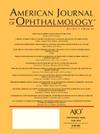Pegcetacoplan治疗36个月以上年龄相关性黄斑变性的地理萎缩:来自OAKS, DERBY和GALE的数据。
IF 4.1
1区 医学
Q1 OPHTHALMOLOGY
引用次数: 0
摘要
目的:报告GALE开放标签扩展研究(NCT04770545)的12个月结果,评估玻璃体内pegcetacoplan治疗年龄相关性黄斑变性(AMD)的地理萎缩(GA)长达36个月。DESIGNGALE是在pegcetacoplan的24个月假对照3期OAKS (NCT03525613)和DERBY (NCT03525600)研究之后进行的一项前瞻性开放标签扩展研究。受试者:完成OAKS、DERBY或1b期APL2-103 (NCT03777332)研究的非中央凹下或中央凹下GA患者。方法spegcetacoplan每月(PM)或每隔一个月(PEOM)给眼。在OAKS和DERBY中,接受pegcetacoplan的眼睛继续相同的治疗方案(PM-PM和PEOM-PEOM),而在OAKS和DERBY中,假手术观察的眼睛在相同的给药间隔(SM-PM和sem - peom)中交叉接受pegcetacoplan。对GALE前12个月的安全性和有效性进行了评估,反映了长达36个月的持续pegcetacoplan治疗。主要观察指标:GA面积的平均变化率、显微检查分形点总数和不良事件。结果在GALE发作的前12个月,92.0%(727/790)的患者有尿潴留。在所有眼睛中,包括非中央凹下和中央凹下GA的眼睛,与投影假体相比,pegcetacoplan将GA面积的平均变化率降低了32%。年复一年,GA面积的平均变化率的减少增加,与GALE第一年的预测假手术相比,PM-PM组非中央凹下GA的眼睛减少了42%。PM-PM在36个月时观察到新的暗点减少18% (P=0.0156),突出了预先指定的显微测量分析的显着影响。不良事件包括渗出性AMD 33只(4.5%)眼,眼内炎症15只(1.9%)(轻度或中度),缺血性视神经病变1只(0.1%),感染性眼内炎1只(0.1%)。无血管炎事件报道。结论在36个月的时间里,pegcetacoplan持续降低GA的生长,随着时间的推移,效果越来越好,减少了新的暗点的形成。pegcetacoplan在GALE前12个月的安全性与之前24个月的OAKS和DERBY研究一致。本文章由计算机程序翻译,如有差异,请以英文原文为准。
Pegcetacoplan Treatment for Geographic Atrophy in Age-Related Macular Degeneration Over 36 Months: Data From OAKS, DERBY, and GALE
PURPOSE
To report 12-month results from the GALE open-label extension study (NCT04770545), evaluating up to 36 months of intravitreal pegcetacoplan treatment for geographic atrophy (GA) in age-related macular degeneration (AMD).
DESIGN
GALE is a prospective open-label extension study following the 24-month, sham-controlled, phase 3 OAKS (NCT03525613) and DERBY (NCT03525600) studies of pegcetacoplan.
PARTICIPANTS
Patients with nonsubfoveal or subfoveal GA who completed OAKS, DERBY, or phase 1b APL2-103 (NCT03777332) studies.
METHODS
Pegcetacoplan was administered monthly (PM) or every other month (PEOM) to all study eyes in GALE. Eyes receiving pegcetacoplan in OAKS and DERBY continued the same regimen (PM-PM and PEOM-PEOM), while eyes observed with sham in OAKS and DERBY crossed over to receive pegcetacoplan at the same dosing interval in GALE (SM-PM and SEOM-PEOM). Safety and efficacy through the first 12 months of GALE were assessed, reflecting up to 36 months of continuous pegcetacoplan treatment.
MAIN OUTCOME MEASURE
Mean rate of change in GA area, total number of microperimetry scotomatous points, and adverse events.
RESULTS
Through the first 12 months of GALE, 92.0% (727/790) patient retention was observed. Across all eyes, including eyes with nonsubfoveal and subfoveal GA, pegcetacoplan reduced the mean rate of change in GA area up to 32% versus projected sham. Year after year, the reductions in the mean rate of change in GA area increased, with up to a 42% reduction observed in eyes with nonsubfoveal GA in the PM-PM group compared with projected sham in the first year of GALE. An 18% reduction in new scotomatous points (P = .0156) was observed with PM-PM at 36 months, highlighting a significant impact in a prespecified microperimetry analysis. Adverse events included 33 (4.5%) eyes with exudative AMD, 15 (1.9%) intraocular inflammation (classified as mild or moderate in severity), 1 (0.1%) ischemic optic neuropathy, and 1 (0.1%) infectious endophthalmitis. No events of vasculitis were reported.
CONCLUSION
Over 36 months, pegcetacoplan continued to reduce GA growth with increasing efficacy over time and reduced formation of new scotomatous points. The safety profile of pegcetacoplan in the first 12 months of GALE was consistent with the prior 24-month OAKS and DERBY studies.
求助全文
通过发布文献求助,成功后即可免费获取论文全文。
去求助
来源期刊
CiteScore
9.20
自引率
7.10%
发文量
406
审稿时长
36 days
期刊介绍:
The American Journal of Ophthalmology is a peer-reviewed, scientific publication that welcomes the submission of original, previously unpublished manuscripts directed to ophthalmologists and visual science specialists describing clinical investigations, clinical observations, and clinically relevant laboratory investigations. Published monthly since 1884, the full text of the American Journal of Ophthalmology and supplementary material are also presented online at www.AJO.com and on ScienceDirect.
The American Journal of Ophthalmology publishes Full-Length Articles, Perspectives, Editorials, Correspondences, Books Reports and Announcements. Brief Reports and Case Reports are no longer published. We recommend submitting Brief Reports and Case Reports to our companion publication, the American Journal of Ophthalmology Case Reports.
Manuscripts are accepted with the understanding that they have not been and will not be published elsewhere substantially in any format, and that there are no ethical problems with the content or data collection. Authors may be requested to produce the data upon which the manuscript is based and to answer expeditiously any questions about the manuscript or its authors.

 求助内容:
求助内容: 应助结果提醒方式:
应助结果提醒方式:


